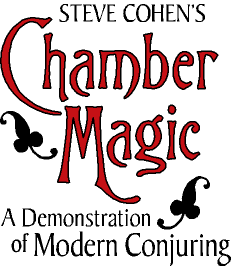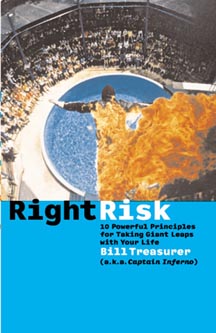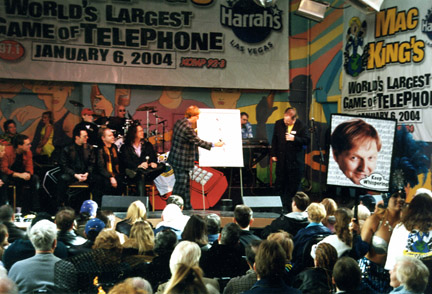This is the Age Of Oomph, the Era of Snap. Having an excellent product or service isn’t enough. Your must deliver your offering to market in a clear, exciting way.
Below are several client stories showing Mark practices what he preaches. Some involve consultants, others involve entertainers. The basic principles in each story work for any business.
A 2,000% Increase in His Fees
The client: Steve Cohen
The situation: Steve was a professional magician, but he couldn’t explain why he was better than his competitors. He had no point of differentiation.
 The solution: While growing up in Chappaqua, NY, Steve learned how to entertain wealthy audiences. He even did shows for captains of industry like David Rockefeller, Jack Welsh, and Michael Bloomberg. But he never mentioned this skill in his marketing.
The solution: While growing up in Chappaqua, NY, Steve learned how to entertain wealthy audiences. He even did shows for captains of industry like David Rockefeller, Jack Welsh, and Michael Bloomberg. But he never mentioned this skill in his marketing.
Mark took Steve’s hard-won skill, and based the conjuror’s identity on it. Steve became “The Millionaires’ Magician.” His tagline: “Entertainment for Exclusive Events.” Mark also helped changed Steve’s show, clothing, prospecting techniques, marketing strategy, and business model, so it would be in keeping with his identity.
The result: Steve has raised his hourly performing fee by 2,000%. He has an off-Broadway show that plays in the penthouse of the Waldorf-Astoria, and has run for seven years. He signed a major book deal with HarperCollins. He’s been profiled in newspapers, like The New York Times and The Financial Times, in magazines like Time Out New York and Lexus Magazine, and on TV, for shows like The CBS Evening News and The Today Show. Steve now has his own TV special in the works.
More Than Doubled His Company’s Revenues
The client: Bill Treasurer
The situation: Bill owned a consulting firm that did leadership development and teambuilding work. His problem? A hundred thousand other consulting firms did the same type of work. Without a compelling marketplace position, Bill’s company seemed ordinary. Because it seemed ordinary, he had a hard time getting prospects’ attention, and was in a weak negotiating position when he did.
 The solution: Bill had written a book, Right Risk, which teaches people how to take risks in their personal lives. The reason Bill was qualified to write such a book was because, prior to becoming a consultant, he had worked for ten years in theme parks as a professional daredevil. As “Captain Inferno,” he would climb a ten-story tower, spray himself with gasoline, set himself on fire, and dive into a water tank.
The solution: Bill had written a book, Right Risk, which teaches people how to take risks in their personal lives. The reason Bill was qualified to write such a book was because, prior to becoming a consultant, he had worked for ten years in theme parks as a professional daredevil. As “Captain Inferno,” he would climb a ten-story tower, spray himself with gasoline, set himself on fire, and dive into a water tank.
Mark took that risk-taking, daredevil ethic, and made it the star of Bill’s business. Now, Bill’s firm, Giant Leap Consulting, “builds courage in organizations.” It helps leaders and employees take the risks they know they should be taking, but don’t. Through one-on-one sessions and workshops, Bill helps drive fear and anxiety out of the workplace, so his clients can boldly and courageously create the future they most want.
The result: “Conservatively,” says Bill, “my revenues have more than doubled, and so has my daily rate.” Before hiring Mark, an $1,800 week would have been good for Bill. After hiring Mark, Bill has had many $10,000 and $20,000 weeks. He also has a couple of retainer contracts that will bring him upwards of $100,000. “My service is in demand,” says Bill, “and at times I’m booked up months in advance.”
Hired Away to Head His Own Division
The client: Robert W. Jacobs (“Jake”)
The situation: Jake ran his own Michigan-based firm, R.W. Jacobs Consulting, with a list of clients including American Express, Ford, Marriott, and the City of New York. He had also written a lauded business book, Real Time Strategic Change. What was the trouble?
Jake’s image had grown fuzzy. His firm had so many kinds of clients, and did so many kinds of projects, that he started having a hard time articulating exactly what he did. He knew that if he wanted to grow his business, he’d have to have a more focused message.
The solution: Jake brought in Mark, who studied Jake’s book, promotional materials, website, marketplace competitors, and interviewed Jake, his colleagues, and his clients. Mark noticed a couple of important things: 1. Jake did his best work handling tough projects involving hundreds and, at times, thousands of people. 2. Most of Jake’s change work centered around a single idea: For a change effort to succeed, the change work must be made part of everyone’s daily work.
These two ideas –- that Jake should only handle big, impossible projects, and that he helped make change “ordinary” –- became the driving forces of his speeches and marketing efforts.
Jake also hired Mark to coach him, and three other consultants, in writing a book, You Don’t Have To Do It Alone: Get Things Done By Involving Others. You can read more about it on this site under the case study entitled “A Field All to Themselves,” but the upshot is this: the book was praised by Fast Company and The New York Times, and further helped substantiate Jake’s new messages.
The result: Jake’s business not only grew, but some major competitors began to notice him. One of those competitors — with 65,000 employees worldwide –- was so impressed with his abilities, that they made him a lucrative offer to start and run their West Coast division. Jake took their offer, closed his firm, and now lives with his family in Los Angeles.
From Writer & Consultant to International Expert
The client: Jeff Cohen
The situation: Jeff started My Communications, a firm that wrote marketing documents for retail stores and offered consulting advice to HR departments. Because Jeff’s company didn’t have a unifying concept, he had a hard time making prospects understand how he could help them.
The solution: Mark interviewed Jeff at length, and discovered something interesting. When Jeff worked in Corporate America, his job was to take his boss’s ideas and make them happen, no matter how daunting the idea. At that job, Jeff excelled. He was a natural project manager and get-it-done guy.
Jeff, in fact, used those same business planning-and-execution skills in his personal life. He had once set up a detailed blind-date program for himself, which included benchmarks, timelines, and other business-strategy techniques. He went on 77 blind dates, before meeting his future wife on date 78.
Mark took Jeff’s adept planning-and-execution skills, and the experience he had gained by going on 78 blind dates, and split Jeff’s business in two: one side focusing on corporations, the other side focusing on the public.
The corporate result: Jeff’s renamed firm, Bold Road Business Services, now helps companies take the intimidation out of goal-setting and execution. Although Bold Road is less than a year old, its clients already include American Express, the Gap, and Brown Brothers Harriman.
The public result: Jeff is now the Dating & Relationship Expert for the Internet’s eleventh most visited site, About.com. Each month his columns get 1.5 million clicks. As a dating expert, he’s been interviewed in USA Today, has appeared on Good Morning America and Voice of America (which has 100 million viewers and is broadcast in 35 countries), and was approached by producers for Oprah and Rachael Ray about appearing on their shows. Jeff has also spoken to an audience of 3,000 at the CBS News live event, ‘HealthWatch,’ where he was featured on the same program as Deepak Chopra and Dr. Dean Ornish.
To learn about the stunt Mark created to help Jeff win the About.com job, click here.
A Book, a Licensing Deal, and a World’s Record
The client: Mac King
The situation: Mac, an NBC-TV entertainer with his own stage show at Las Vegas’ Harrah’s Casino, wanted two things: a book his staff could sell following his performances, and a way of attracting attention to his act. In particular, attracting attention was tough. Mac’s competition: Celine Dion, Wayne Newton, and Cirque du Soleil.
The book solution: Mac and Mark wrote a book, Tricks With Your Head, which was based on Mac’s on-stage character and marketplace position.
The book result: Tricks With Your Head was published by industry-giant Random House, sells in every major book retailer in America, has been reprinted four times, and resides in the libraries of Bill Gates, George Lucas, and the father of permission marketing, Seth Godin. The book also got Mac on at least 150 radio and TV programs. And, at the end of Mac’s twice-daily show, his audiences lines up to buy copies, which he autographs.
A couple of important, unexpected side benefits: Mac also used the book to snag his own weekly newspaper cartoon with a major syndication agent, and scored a big licensing deal with KFC.
 The attention solution: Mark devised a publicity stunt, “Mac King’s World’s Largest Game of Telephone” (based upon the children’s game, in which the first person in line whispers a phrase to the second person, who whispers it to the third person, and so on. By the time the phrase reaches the last person, the phrase has totally changed). Mac promised the media that not only would it be the largest game played, but he would also predict what the phrase would change to, once it reached the end of the line.
The attention solution: Mark devised a publicity stunt, “Mac King’s World’s Largest Game of Telephone” (based upon the children’s game, in which the first person in line whispers a phrase to the second person, who whispers it to the third person, and so on. By the time the phrase reaches the last person, the phrase has totally changed). Mac promised the media that not only would it be the largest game played, but he would also predict what the phrase would change to, once it reached the end of the line.
The attention result: The stunt set a Guinness world’s record (615 people, including such Vegas personalities as Penn & Teller, Sheena Easton, Robin Leach, Clint Holmes, and Lance Burton). Mac did indeed predict the final phrase (actually, he was off by one word). He appeared on MSNBC, FOX-TV, and 62 other stations. He was interviewed on radio programs and for newspapers. The Nevada State Government gave him an award. Harrah’s handed out $5,000 in prizes. A rousing success.
A Field All To Themselves
The client: The Axelrod Group
The situation: Dick and Emily Axelrod are corporate change consultants who have done projects for Boeing and Coca-Cola, among others. The Axelrod’s core business belief: employees will be more likely to do whatever’s necessary to make sure a change happens, if they have a hand in creating the change initiative in the first place.
Dick contacted Mark to help him solve several problems: His website and promotional materials seemed drab. He wondered if there was a way to give his materials more pop, without making him come across as a huckster.
He also wanted help with a book. He, Emily, and two other notable consultants had tried to write it earlier with the help of another coach, but things didn’t work out. One of the consultants even reported that her writing ability had gone backwards. She now felt blocked.
The materials solution: To make the Axelrod’s materials sing, Mark needed to develop an identity which was intriguing and did justice to their work. He threw out their old “OD consultant” label, and made them into “Collaborative Change Experts.” They had a newly named, easily-understood field all to themselves.
He also gave their approach a fresh name, “Organizational Barnraising.” It’s a metaphor based upon the old-time barnraisings, in which an entire community would erect a sturdy building in a day. It fits what the Axelrods perfectly. They bring together people from inside and outside the corporation to accomplish what none of them could do on their own.
Along with these names, he helped develop a logo, a website (www.axelrodgroup.com), a sales pitch, and a comprehensive e-learning project. All these projects strengthen the Axelrod brand. Says Dick: “Now when I’m giving a sales presentation to a corporation everyone instantly gets what I’m saying. They understand it, they remember it, and it has impact. This way makes a huge difference. My old presentations just didn’t have that punch, and that made selling harder.”
The book solution: First, they had to write a book proposal. Mark and the four consultants held weekly phone sessions over the course of two months. During these sessions they created the book concept, refined it, discovered ways to substantiate it, made it compelling, and fit the material into proposal form. Mark also gave the consultants homework, and techniques that would make their writing lively and simpler to do.
The consultants didn’t want to shop the proposal around. They wanted one particular house to sign them. They sent the proposal to that house; it was accepted.
Mark then acted as their writing coach, while they wrote and edited their manuscript. The resulting book, You Don’t Have To Do It Alone: Get Things Done By Involving Others, was released in September of 2004. Fast Company soon featured it, and the Sunday New York Times called it “a complete blueprint for involving others” and “the best” of the recent involvement books. Mark told Dick and the other three consultants to double their fees.
A side note: Dick thinks that the writing and perspective-twisting Mark had him do for his book has helped him in his day to day business. Says Dick: “Your exercises made me get clearer about my message. They forced me get to the essence of what I believe in and what I want to say. Now I feel more confident in my writing and speaking, because I’ve thought about things deeply, through a number of perspectives.”
A Public Demonstration Launches a Bestseller
The client: Mark Levy
The situation: When Mark’s book, Accidental Genius, was released, he wanted to publicize it. That, though, was a tall order. The book was from a small press without much money, and it dealt with a subject that wasn’t sexy: how to use private writing as a problem-solving tool. He knew if anyone was going to pay attention to it, he’d have to do something imaginative.
The solution: He issued a news release with the headline, “Man Prepares to Stop Midtown Traffic With His Mind,” and that’s what he did. He arranged to sit in the window of the country’s largest bookstore at their busiest time of night, and demonstrated his problem-solving technique for four continuous hours. He typed into his laptop, and what he wrote was projected onto a screen mounted against the window.
The result: His demonstration became a happening. Hundreds of people stopped to read what he was writing. He was interviewed on CNN-FN. The store, which normally sells two copies of a given book, has sold over 800 copies of Accidental Genius. News of what he did even helped sales in other parts of the country; for instance, Borders Books reported that his work was the third best selling business book on Wall Street.
The Perfect Business Expansion Vehicle
The client: Joel Bauer
The situation: The Wall Street Journal Online calls Joel “the chairman of the board” of corporate trade show rainmaking. Corporations like Microsoft and Mercedes-Benz hire him to draw crowds and secure thousands of sales leads.
Joel wanted a website that forcefully conveyed the benefit in hiring him, and a book he could use to publicize his business.
The website solution: See for yourself: www.infotainer.com. Mark wrote the text. You’ll notice that every word and image drives home a single point: that Joel draws crowds. That’s his marketplace position. His guarantee is about crowds. His advice is about crowds. His time-lapsed photos are about crowds. Even his biography stresses crowds (he’s performed before twenty million people live, and 150 million more on TV).
The book solution: Joel and Mark wrote a book, How to Persuade People Who Don’t Want to Be Persuaded, which was published by Wiley. The book teaches readers how to use the secrets of professional pitchmen to influence others in everyday life. It’s been as high as #6 on BN.com and #71 on Amazon. Joel is using this book to hit the talk shows and expand his lucrative business as a public speaker.
Mark asked Joel what most impressed him about the work he did for him on the book. Joel said, “Besides the writing, it was your ability to sell the proposal. You kept coming up with new ideas for the book and how to position it, until it became impossible to refuse. In a short time, you did what I couldn’t do in 25 years.”
Pingback: Tell me a story | Credible Communications